Cell Division/Cancer – Flashcards
Unlock all answers in this set
Unlock answersquestion
3rd phase; the chromatids of each chromosome separate at the centromere and move in opposite directions
answer
Anaphase
question
An ordered sequence of events in the life of a eukaryotic cell, from its origin in the division of a parent cell until its own division into two.
answer
Cell Cycle
question
Process of cytoplasmic division in plant cells; after nuclear division, a cross-wall with plasma membrane on both surfaces forms and divides the cytoplasm.
answer
Cell plate formation
question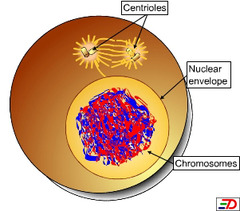
Centrosome, Mitotic spindle Basal bodies

answer
Centriole
question
Area where the chromatids of a chromosome are attached

answer
Centromere
question
Bodies within the nucleus made in DNA and proteins called the histones
answer
Chromosome
question
-sum of all chromosomes in cells of a given type. Humans have 46 chromosomes. Body cells are diploid (2n) Sex cells are haploid.
answer
Chromosome number
question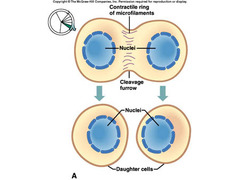
The first sign of cleavage in an animal cell; a shallow groove in the cell surface near the old metaphase plate. (Animal cytokenesis)

answer
Cleavage furrow
question
After nuclear division, a splitting of the parent cell cytoplasm that completes the formation of daughter cells, cytokenesis
answer
Cytoplasmic Division
question
When the nucleus contains both pairs of all chromosomes. (2N)
answer
Diploid (chromosome number)
question
A special type of diploid cell that will divide by mitosis to produce replacements but also divide by meiosis to produce gametes. Reproductive cells
answer
Germ cell
question
the most famous and widely used cancer cells; they grow aggressively and heavily favor cell reproduction over cell death; cervical cells in Henrietta Lacks
answer
HeLa cell
question
Globular protein that assist in DNA packaging in eukaryotes. Histones form octamers around which DNA is wound to form a nucleosome.
answer
Histone
question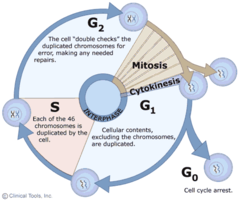
Cell grows, performs its normal functions, and prepares for division; consists of G1, S, and G2 phases

answer
Interphase
question
A structure of proteins attached to the centromere that links each sister chromatid to the mitotic spindle.

answer
Kinetochore
question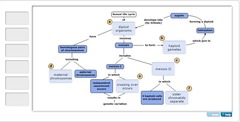
Cell division that produces reproductive cells in sexually reproducing organisms

answer
Meiosis
question
Centromeres of duplicated chromosomes are aligned at plate. Fully formed spindle attach to the sister chromatids from opposite poles
answer
Metaphase
question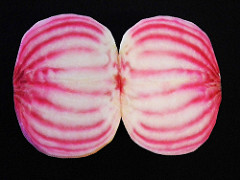
A process of nuclear division in eukaryotic cells conventionally divided into five stages: prophase, prometaphase, metaphase, anaphase, and telophase. Mitosis conserves chromosome number by equally allocating replicated chromosomes to each of the daughter nuclei.

answer
Mitosis
question
A protein that interacts with cytoskeletal elements and other cell components, producing movement of the whole cell or parts of the cell.
answer
Motor protein
question
A structure composed of two coils of DNA wrapped around an octet of histone proteins. The nucleosome is the primary form of packaging of eukaryotic DNA.

answer
Nucleosome
question
Centrioles move to opposite ends and DNA coils into chromosomes
answer
Prophase
question
Formation of new cells or a new individual
answer
Reproduction
question
Replicated forms of a chromosome joined together by the centromere and eventually separated during mitosis or meiosis II.
answer
Sister chromatid
question
Any cells in the body other than reproductive cells
answer
Somatic cell
question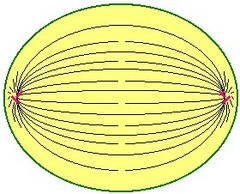
Dynamic, temporary array of microtubules that moves chromosomes in precise directions during mitosis or meiosis.

answer
Spindle apparatus
question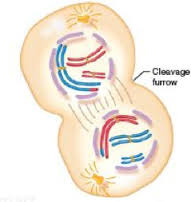
After the chromosome separates, the cell seals off, Final Phase of Mitosis.

answer
Telophase
question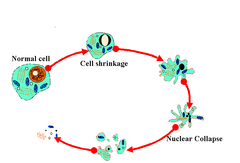
A type of cell death in which the cell uses specialized cellular machinery to kill itself

answer
Apoptosis
question
Critical for introducing gap stages into cell cycle and slowing it down; take over and regulate accumulation of cyclins in cell as maternal replication factors are depleted
answer
Cell cycle regulators
question
Outside villi
answer
Cell division location
question
Crypt -> lumen
answer
Cell differentiation location
question
Top of villi
answer
Apoptosis location
question
Hair loss
answer
One harmless result of too little cell divsion
question
Warts
answer
One harmless result of too much cell division
question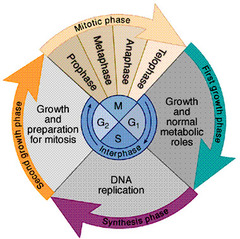
g1, s, g2, m

answer
Cell cycle phases
question
Check to see if previous phase went ok
answer
Purpose of a checkpoint in the cell cycle
question
Cancer
answer
Potential outcome when error occurs in checkpoint of cell cycle process
question
Stimulating protein
answer
Type of protein that regulates the cell cycle that is encoded by proto-oncogenes
question
Inhibitory protein
answer
Type of protein that regulates the cell cycle that is encoded by tumor suppressor genes
question
CDKs (cyclin-dependent kinases)
answer
Most important cell cycle regulator
question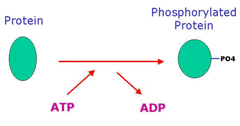
An enzyme that transfers phosphate ions from one molecule to another

answer
Kinase
question
-Right after cytokinesis -Cell increases in size and preps for DNA replication -Checkpoints are for no DNA damage and sufficient resources
answer
G1 Phase Events
question
-Cell keeps growing -Preps for division Checkpoints are for no DNA damage, enough cell components, and that the chromosome set is complete
answer
G2 Phase events
question
-Cell replicates its DNA -2 complete sets of chromosomes Checkpoints are for no errors during DNA replication
answer
S Phase events
question
-Cell stops growing -Divides into two identical daughter cells -Checkpoint is for all chromosomes attached to mitotic spindle
answer
M (mitosis) Events and checkpoints
question
G1, S, and G2 phases
answer
Parts of interphase
question
Increase the speed of cell division = putting the foot on the accelerator
answer
What do mutated proto-oncogenes cause?
question
-Brakes (normal) TS gene, inhibiting cell growth -One mutation, cell cycle is okay -Two mutations, cell cycle proceeds too quickly
answer
What do mutated tumor suppressor genes cause? (And difference between one mutated tumor suppressor gene vs. two)
question
Drug blocks BRAF protein, thereby stopping cell replication
answer
How does BRAF protein melanoma treatment work?
question
Mapping genomes of cancer over different tumor types, completing map of common mutations of every major cancer type, and then guiding medicine based on patient's genome
answer
Current cancer discoveries
question
Tumors are sequenced, mutations are identified and drugs that block specific proteins are prescribed
answer
Mutation based medicine
question
An uncontrolled growth of cells, a genetic disease, a family of similar diseases. Health cells turn into the enemy due to dividing too quickly or abnormally, growing in all directions. Cells stop listening to the body, which is telling them to stop
answer
Cancer definition
question
Mutations in DNA can turn normal cells cancerous, these can be inherited or spontaneous
answer
Cancer as a genetic disease
question
Cells which protect the body from air and internal fluids
answer
Carcinomas
question
From cells in supportive tissue
answer
Sarcomas
question
From cells in blood and immune system
answer
Leukemias and Lymphomas
question
Chemicals, viruses, or radiation from the Sun. All of these lead to mutations of DNA in your cells. People can also be predisposed to getting cancer by inheriting mutations from parents
answer
Common Causes of Cancer
question
Anything that leads to mutations of DNA in one's cells
answer
Mutagens
question
Responsible for most cancers of larynx, oral cavities, pharnyx, esophagus, bladder, and lungs
answer
Cigarette smoking
question
may be related to cancers if regularly consumed
answer
Alcohol
question
Some DNA is deleted, this is then copied without all necessary parts to RNA, and a mutant/abnormal protein is produced
answer
How is a mutant protein made?
question
The abnormal proteins don't work properly at cell checkpoints, allow replication to proceed out of control.
answer
How could a mutant protein make cells divide out of control?
question
-Tumor-Suppressor Genes -Oncogenes
answer
Which two categories of genes can lead to cancer?
question
Normally inhibit cell growth, but mutations in them may inactivate them, and then they stop stopping cell-growth Ex. p53
answer
Tumor-suppressor genes
question
They normally promote careful cell growth, but a mutation can over activate them, leading to non-stop cell growth Ex. RAS
answer
Oncogenes
question
In a tumor suppressor genes, turning genes off causes cancer. In oncogenes, turning genes on leads to cancer
answer
Mutation of TS and Oncogenes to cause cancer
question
A non-malignant tumor lacking the ability to invade surrounding normal tissue
answer
Benign
question
A tumor that tends to grow, has the capacity to invade nearby tissue and spreads through the blood stream
answer
Malignant
question
1) forms a tumor 2) Recruits a blood supply (angiogenesis) 3) Spreads to other parts of body (metastasis)
answer
How cancer cells become dangerous
question
Advanced stages of cancer, cancer cells are spreading to other parts of the body
answer
Metastasis
question
Tumors recruiting a blood supply (solid tumors only)
answer
Angiogenesis
question
cancer cells enter blood vessels, blood vessels travel to distant sites, cells invade new tissues and begin to grow
answer
Spread of cancer
question
Drugs (chemo), radiation, surgery
answer
3 types of treatment
question
Secondary tumors, the cancer has spread. Treatment is chemotherapy (drugs)
answer
Metastatic and treatment for this
question
one place, treatment is surgery and/or radiation
answer
Local and treatment for this
question
Killing a fly with a cannon ball, it's hard to target just cancer cells, so lots of other cells also get affected
answer
Selectivity
question
Hair loss from hair follicle cells, bone barrow cells lead to weak immune system, gut lining cells lead to diarrhea, skin leads to flaky/scaly skin
answer
Side effects from selectivity of chemo
question
Discover new drugs that attack most important mutations, or use the immune system to fight cancer, or use "failed" drugs to target genes that could be blocking cancers
answer
Cancer drug goals
question
-To reproduce an entire organism, increasing population -To repair dead or damaged cells -Allow multicellular organisms to grow and get bigger -Diffusion takes too long if cells get too big, cells need to remain small
answer
Why do cells divide?
question
Distribution of identical genetic material- DNA- to two daughter cells. A dividing cell duplicates its dNA, allocates two copies to opposite ends of cell, then splits into two daughter cells
answer
Cell division requirements
question
A cells DNA, usually several DNA molecules in genome of eukaryotes (46 for humans), in prokaryotes genome is usually one long DNA molecule
answer
Genome
question
Each eukaryotic species has characteristic number of chromosomes in nucleus. Somatic cells have 46 in humans, gametes have 23
answer
Chromosomes
question
Body cells, have 46 chromosomes in people
answer
Somatic cells
question
Sperm or egg cells, have half the number of a somatic cell, 23 chromosomes in people
answer
Gametes
question
Two sister chromatids in each duplicated chromosome, they contain identical copies of each others DNa. When they condense, the area between the two is called the centromere. they are eventually pulled apart and repackaged into two new nuclei at opposite ends of parent cell
answer
Sister chromatids
question
Area between two chromatids as they condense
answer
Centromere
question
Formation of two daughter nuclei, and followed by division of the cytoplasm, called cytokinesis
answer
Mitosis
question
Division of the cytoplasm
answer
Cytokinsesis
question
taking one cell and producing two cells that are genetic equivalent of the parent
answer
Mitosis and Cytokinesis joint goal
question
-23 chromosomes from each parent, one set in egg, one set in sperm -Trillions of cycles of mitosis and cytokinesis to produce fully developed human -Continue every day to replace and rebuild dead/damaged cells -Producing clones, cells with the same genetic information
answer
Human mitosis cycle
question
-Grow the cell -Repair dead or damaged cells
answer
What are 2 reasons why cells must divide?
question
No, they can enter G0 phase
answer
Do all cells continually divide?
question
Chromosomes within the nucleus
answer
Where is DNA located in eukaryotic cells?
question
It is packaged into chromosomes. While in the nucleus, it is in the form of loose-chromatin, and once the nuclear envelope dissolves, it gathers into two sister chromatids, which will later be pulled apart and repackaged
answer
How is DNA organized within eukaryotic cells? Explain the various levels of organization
question
Includes mitosis and cytokinesis. Alternates with the much longer interphase
answer
Mitotic phase
question
90% of the cell cycle. three subsets: g1, S, and G2
answer
Interphase
question
-Nucleoli disappear -Chromosomes are tightly coiled, with sister chromatids joined together -Mitotic spindle begins to form, appears to push chromosomes away from each other toward poles of the cell
answer
Prophase
question
-Nuclear envelope fragments and microtubules from the spindle interact with the chromosomes -Microtubules from one pole attach to one of two kinetochores, special regions of centromere, while microtubules from other pole attach to other kinetochore
answer
Prometaphase
question
Spindle fibers push the sister chromatids until they are all arranged at metaphase plate, imaginary plane equidistant between the poles that defines metaphase
answer
Metaphase
question
Centromeres divide, separating sister chromatids. Each one is now pulled towards pole to which it is attached by spindle fibers. Each pole has equivalent collections of chromosomes by the end
answer
Anaphase
question
Cells continue to elongate as the free spindle fibers from each centrosome push off each other -Two nuclei begin to form, surrounded by fragments of old nuclear envelope -Chromatin becomes less tightly coiled -Cytokinesis, the division of the cytoplasm, begins
answer
Telophase
question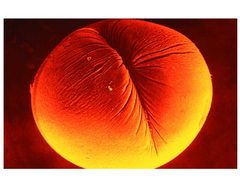
first sign of cytokinesis, when cleavage furrow in cell surface begins to appear

answer
Cleavage
question
Metaphase
answer
In what stage of mitosis do chromosomes line up in the middle of the cell?
question
Interphase, because this involves lots of time to grow
answer
In what stage of the cell cycle do cells spend the most time? Why?
question
If a sister chromatid did not separate during anaphase, one cell would have an extra chromosome and the other would have one less chromosome. This would result in problems if the cell was able to continue to grow and divide. However, the cells structure would remain intact.
answer
What would happen if a sister chromatid did not separate during anaphase? What structure(s) remains intact? What would be the result on the cells produced?
question
It becomes more likely that there is a division in which the sister chromatid do not separate during anaphase, causing a mutation or other error, which will lead to defects in the cell.
answer
What do you think happens when cells divide too quickly and out of control?
question
Checkpoint chemical, if everything is good then this is released and moves cell to next stage
answer
CDK-Cyclins phosphorylate proteins
question
When they are bound to cyclins (proteins)
answer
When are CDKs present inside the cell during the cell cycle?
question
Cycles up and down depending on phase
answer
When are cyclins present inside the cell during the cell cycle?
question
Stimulate the cell cycle, leading to cell division
answer
What do activated CDK-Cyclin complexes do?



